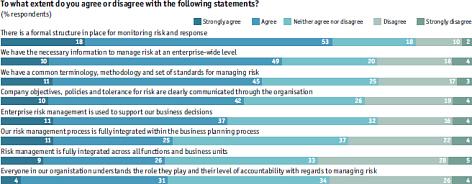Improve your failed IT culture

The underpinnings of IT failure lie in culture, the unspoken rules governing an organization's style and general priorities. Since most organizations pay little attention to project culture, it's not surprising failure rates remain high.
New research by SAS sheds light on this issue. In a survey of 316 senior financial industry executives sponsored by SAS, the Economist Intelligence Unit explored the role of culture in enterprise risk management (ERM):
Creating a culture for risk management is a challenging proposition for most firms. One of the keys to successful risk management is embedding risk management within the company culture, but for surveyed executives this was the most widely encountered challenge, cited by almost one-half of respondents.
Although a bit hard to read, the following chart clearly shows most respondent's organizations don't have a high-priority culture around enterprise risk management. That's a problem, given the importance of this topic:
Although the study focuses on enterprise risk management, the results offer important lessons for reducing IT project failures. The report says:
Among the difficulties that need to be addressed is a reluctance to change, or a reluctance to assume the responsibilities of risk management.
Let's a put this in more pointed terms related to project failures: many managers naively believe they can improve project delivery by making pronouncements and demands from IT staff. Sorry, but it just doesn't work that way. To improve projects consistently, you must inject a success priority into the organization. That means changing the culture around how your team handles projects.
At the risk of over-simplifying, three steps are required to build and IT success culture:
- Establish priorities. Don't expect to go from lousy projects to perfection overnight -- it just won't happen. Instead, establish IT project success as a strategic initiative. Improving projects won't happen as a one-shot deal with short-term focus; you must make this focus a permanent part of the IT landscape.
- Invest in activities. Words are not enough. Invest in training, objective project reviews, serious post-mortems, and information sharing. This new IT success initiative will cost you money and will require the team's time. Don't have time or money for any of this? Then acknowledge failure as an important part of your culture and stop wasting your time.
- Demand conformance and reward improvement. Make sure both senior management and the IT team understands you're serious about improving IT execution. Establish guidelines for project planning, requirements gathering, testing, and so forth; then demand everyone follow the rules. Importantly, reward the team when even small signs of success become visible. When positive sign appear, treat the team to something special.
Culture change takes time and effort, so it's tempting to cut corners. Of course, that's why so many organizations run an endless series of late and over-budget projects. The most important first step is recognizing the need to change. Let management and colleagues know that you've made IT success job number one.
If you repeat that message often, backed up with action, your project success rate will most assuredly improve.